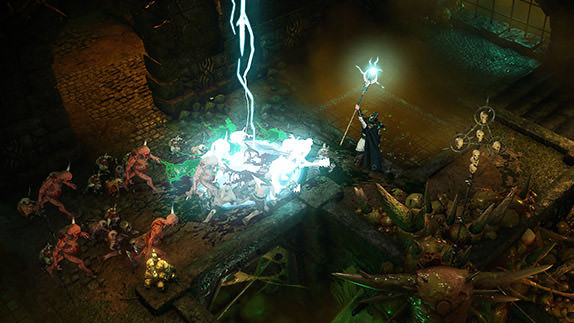The Surge Review

 By Kevin Mitchell | Posted: May 15, 2017
By Kevin Mitchell | Posted: May 15, 2017
Unbeknownst to From Software at the time, the Souls franchise has not only won the hearts of millions of gamers around the globe but has sparked the creativity of other studios in helping to create a new genre of games. Deck13's first attempt at a Souls-like action role-playing game, Lords of the Fallen, was met with a mixed reception, with fans of Dark Souls feeling the combat was a bit too slow and janky at times. In The Surge, Deck13 has transitioned to a science fiction setting, complete with tight atmospheric corridors, wide-open junkyards, uniquely designed bio labs, and massive bosses. The differences between The Surge and Dark Souls are quite apparent, and I have no problem saying that The Surge is one of the best action RPGs I've ever played.
The Surge doesn't feature any character customization, something that fans of the genre will be disappointed to hear, but with the sheer amount of gear that you can equip, I never found the limitation affecting my enjoyment of the title. Deck13 has set a grim vision of our future, where overpopulation and disease have brought the Earth to the brink of annihilation. Technology has advanced to the point where many human jobs have become redundant. Players take on the role of Warren, who just so happens to be starting his new role as a factory worker. To assist and make human lives better, everyone is outfitted with an exo-rig that allows you to equip different types of gear based on the role you wish to take. From the onset, it's clear that something is wrong, and Warren finds himself in the deep end between trying to survive and uncover the mysteries and true intentions of CREO. While they claim to be reviving the atmosphere and trying to heal the world's ecology, there are certainly questionable experiments happening at the same time.
Although you don't have any control over Warren's basic appearance or class, you define his role by the type of armor pieces and weapons you equip. The first two armor sets are opposites, giving players a taste of each, letting them decide how they want to proceed. While providing less defense, the lighter gear set LYNX provides an attack speed bonus for each piece equipped, as well as decreases the stamina cost for dodging and blocking. The massive RHINO gear set has a much higher defense rating, an adverse effect on attack speed, but can prevent you from being staggered. Equipping full sets of specific armor types provides additional bonuses. To acquire new pieces, you must cut them from the limbs of your enemies. The system works much better than traditional role-playing games that rely on small percentage drops.
Deck13 has vastly improved the combat system from Lords of the Fallen, implementing much faster mechanics, blended with a satisfying limb targeting system. Upon targeting, you notice that specific body parts are either marked as being armored or not, which allows you to focus on what's important for that particular engagement. If you are trying to get past the foe as quickly as possible, opt to target and attack any part that is not armored. Instead of using a light and heavy attack, you can swing your weapons horizontally or vertically. Each weapon type has various combos that you can perform by using a combination of the two. However, if you want to acquire new schematics, target the limb you want. As long as you hit that particular limb enough, you are given a chance to cut it clean off. While your stamina drains with every swing of your weapon, as well as every dodge and block, energy is gained by successfully causing damage to enemies. If you reach a set amount, you can perform finishing moves that not only provide you with schematics for the armor attached to the limb you just separated from the body but also a satisfying slow-motion visual flair. In fact, during this sequence, you can activate the game's photo mode. It's currently barebones, only including basic camera control and HUD removal options, but Deck13 may add more robust features down the line.
Holding block will quickly drain your stamina, but a perfectly timed block can stagger the attacker, leaving them open to punishing counter-attacks. Blocking isn't a one-step process, however, as you have three different types: standard blocks, ducking, and jumping. If you see an enemy run towards you and leap into the air, you will only be able to duck under their attack. If you do either of the other two blocking options, you will be setting yourself up for disaster. It's an interesting risk-vs-reward system that truly punishes you if you guess wrong.
Weapons are acquired by either finding them scattered about in the different areas or by removing the limb that was holding the weapon. Unlike gear, which has to be crafted back at the safe house, weapons can be used immediately. They operate in the same fashion when it comes to upgrading them, requiring you to spend crafting materials and a set amount of your tech. Tech is the standard currency in the game, similar to souls or blood echoes from Dark Souls and Bloodborne respectively. Instead of leveling up a single stat, you spend tech to improve your overall core power. Not only does this increase your health, but it allows you to equip better gear and implants. Everything in the game has a set core requirement, and if you don't have any more available core powers, you won't be able to equip anything else. Unlike other games in the genre, tech can be banked, allowing you to save as much as you want. In doing so, you lose out on a multiplier, but it has saved me from some embarrassing deaths in the past. There are a handful of varying weapon types, and within each one, you'll find multiple weapons. Each yields various types of damage, such as elemental, crush, or slash, as well as their own stat bonuses. The more you use a particular weapon type, the more proficient you'll become, increasing the damage output for every weapon you own of the same type. Some weapons gain proficiency much quicker than others, so you want to grind for tech with ones that do, then switch to your favorite when finished.
Implants are your ace up your sleeve, providing boosts to health, stamina, energy, and even additional damage for your weapons. Depending on your playstyle, you may want to load up on extra health to perfect your tank build, or you can focus on more stamina for non-stop attacks, or focus on quickly building and keeping your energy meter filled, allowing you to perform more finishing maneuvers and call your drone more often. You can also convert energy into health, enabling you to not focus on carrying more health items and instead focus on other aspects. The first few implants are quite weak, but by the time you have spent 20 hours in the game, you'll be finding ones that are double or triple efficient.
Returning to the operation center resets the loop in the game, respawning all standard enemies but leaving open any shortcuts that you've already located. These shortcuts are the backbone to advancing in the game. Why would you want to fight every single enemy on the way to a boss when heading through the previously closed-off maintenance shaft can take you right to the boss with only a handful of engagements? They also come in handy when you die, and you are forced to reclaim any tech that you were holding at the time. The Surge plays hardball, adding a time limit, requiring you to work fast if you want to recover your lost tech. Killing enemies will increase the timer, so simply running past them puts you at a disadvantage. The game's narrative is told through a three-fold approach: audio logs, non-playable characters that will have side-quests for you, and interacting with someone trapped in the facility that needs your help. The game doesn't offer many details at the start, or even through the entire first area, but that was intentional, as the narrative builds as you progress. By the time you are nearing the halfway point, you'll become very invested in the story and assist every non-creature that you come across. With that said, The Surge does have plenty of locked doors that require you to backtrack later on, or you can save it for a new game plus playthrough.
Although the game takes place on Earth, the game's sci-fi heritage shines through, with a stark contrast between the bright blue sky outdoor areas and the atmospheric and claustrophobic corridors. The music clearly sets the mood, adding to some tense moments in the near pitch-black underground sections or when the fog starts to envelop the surface. Physics-based tattered cloth hangs from factories, gently waving in the breeze, and blue and orange sparks provide subtle lighting in dimly lit ventilation shafts.
Simply Put
The Surge is without a doubt one of the best Souls-like titles to be released. Deck13 has certainly proven that they have listened to the feedback from their previous game and has crafted an epic sci-fi action RPG. While boss encounters are vastly unique, the journey to their location is the highlight in The Surge. Even so, The Surge still puts up quite a challenge but rewards players that equip gear and implants that match their playstyle.
Note: The Surge was reviewed on PlayStation 4. A digital copy of the game was provided by the publisher/developer.




